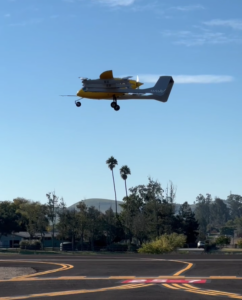Wisk becomes first-ever passenger eVTOL company to complete flights in greater Los Angeles
This summer we publicly demonstrated autonomous flight at one of the largest gatherings of aviation enthusiasts in the world. However, our history of flight and our flight test program spans over a decade, with flights taking place on two continents (learn more about our history of flight below). The learnings that we’ve gathered over this time enable us to confidently say that autonomous passenger flight is possible and it’s happening today. These learnings also enabled us to expand our flight test program beyond our primary test facilities and add to the number of places we’ve flown. This includes our latest “away” test flights in Long Beach, CA.
World’s First Public Demonstration
Oshkosh 2023, marked another aviation first for Wisk, when we completed the world’s first public demonstration of an autonomous eVTOL fixed-wing aircraft.
Our flight at Oshkosh served multiple purposes. The most visible purpose was demonstrating how safe and quiet an autonomous, all-electric air taxi is for the general public, it also provided tremendous value and learnings for our flight and operations team.
Expanding our flight test program: KSBP, KOSH, KLGB

Wisk conducts an away demonstration flight at San Luis Obispo County Regional Airport in October 2022.
This laid the foundation for our demonstration flights at Oshkosh and, ultimately, provided tremendous insight on operating autonomous aircraft within highly controlled airspace.
In October, we began our next set of test flights at Long Beach airport in the greater Los Angeles area, making Wisk the first-ever company to complete eVTOL flight tests in Los Angeles.
Autonomous flight is happening now
These away demonstrations and test flights serve multiple purposes, one of which is to share what we’ve been working on for the past 13 years with the public. They also serve to demonstrate to the general public, regulators, and government officials, that autonomous flight is possible today across a myriad of environments. From controlled to uncontrolled airspace, low-density and high-density airspace, and general to commercial aviation airports, we’ve proven that we can integrate into existing national airspace today. More importantly, we’ve proven that we can do this safely and effectively, with minimal interruption to existing operations.
Our history of flight
Over the past 13 years, we’ve completed more than 1700 test flights across five generations of aircraft. Each generation has taught us new things about our design, and each test flight evolves the maturity of our flight testing and operations program. Each generation also achieved unique milestones and “firsts” for Wisk, as well as aviation industry firsts based on the public information we have been able to find.
Generation 1 was autonomous and built as a full-scale proof of concept, which taught us that our concept was viable. This aircraft set two world’s first milestones – including the world’s first full transition of an eVTOL aircraft and the world’s first full transition of an autonomous eVTOL aircraft. This was the first time in the history of aviation that this had ever been done by an all-electric aircraft.
Generation 2 evolved the Generation 1 into a piloted aircraft. We learned that our aircraft size needed to be bigger due to limitations in existing battery technology. We used this iteration to focus on wing-borne characteristics, as well as system validation and flight-test team maturation in preparation for the Gen 3 aircraft. Generation 2 provided us with the opportunity to go through the safety-of-flight process, where we further developed our understanding of the rigor and discipline required to ensure pilot safety in eVTOL aircraft. This aircraft was the first fly-by-wire, all-electric, human-rated aircraft
Generation 3 was used to test and validate our new wing and lift fan configuration and was essential for testing the placement and number of booms. Our 3rd Generation aircraft achieved a world first with the first piloted eVTOL hover and the world’s first piloted eVTOL transition.
Generation 4 and 5 have very similar body shapes but different vertical propulsion systems, avionics, and software. Both generations were used to test airspace integration and autonomous flight in controlled airspace. These generations also allowed us to expand our flight envelope, upgrade our software and hardware systems, develop our autonomous concept of operations, and much more. Generation 5 also completed the world’s first public flight of an autonomous, fixed-wing, eVTOL air taxi.